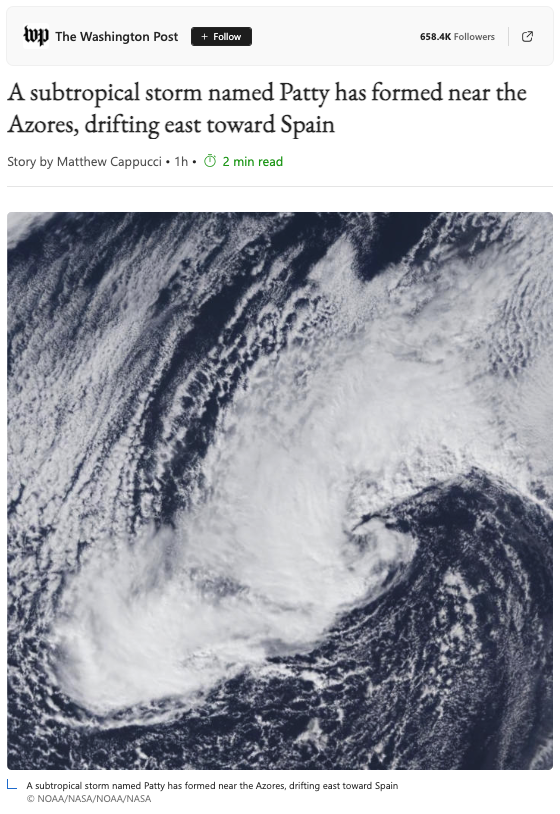
A subtropical storm — in essence a hybrid between a tropical and a nontropical storm — has formed near the Azores, prompting warnings for the entire Portuguese archipelago. The 16th tropical or subtropical storm to form in the Atlantic basin during the 2024 hurricane season has been named Patty.
That means the disturbance that could come together in the Caribbean early next week would get the name “Rafael.”
Patty has maximum sustained winds of 50 mph. The Azores Meteorological Service has issued a tropical storm warning for the island chain. The system should maintain strength as it drifts east-southeast, then gradually lose tropical characteristics Sunday evening.
By Monday, it will devolve into a remnant low, probably bringing some breezy winds and showers to the Iberian Peninsula into Tuesday.
How did this surprise storm form?
Subtropical storms are neither tropical nor nontropical. They combine attributes of both. And they often form in sneaky ways.
On Friday morning, for instance, the National Hurricane Center projected only a 10 percent chance that the antecedent system would form. By evening, those odds grew to 40 percent, then 60 percent overnight.
What happened was that a pocket of thunderstorms developed at the core of a non-latitude low that was traversing the North Atlantic. Water temperatures were marginal, and probably couldn’t support a fully tropical system.
At first, that flare-up of shower and thunderstorm activity was unremarkable. But it continued to blossom, eventually cultivating its own self-contained pocket of warm air. That small warm-core system detached from any fronts associated with the midlatitude nontropical low.
Around the same time late Friday, an instrument mounted aboard a European MetOp satellite estimated gale-force winds exceeding 40 mph — meeting the criteria for a named storm.
By Saturday morning, thunderstorm activity had increased to the point that, in tandem with strong winds, it met the definition of a subtropical storm.
What to know about subtropical storms
Subtropical storms were a source of meteorological debate as early as the 1950s, because structurally, they weren’t quite tropical or nontropical — but could have the same impacts as conventional named storms.
The National Hurricane Center began recognizing them in 1972 but didn’t start naming them until 2002.
Due to their hybrid nature, subtropical storms can form or maintain strength over water temperatures cooler than the roughly 79 degree threshold needed for a tropical system. That means they can form outside the conventional hurricane season and farther north than hurricanes form.
Meanwhile, there’s more to track in the Atlantic. A disturbance in the Caribbean has an 80 percent chance of eventual development. It could become a tropical system into early next week, and would be called Rafael.
